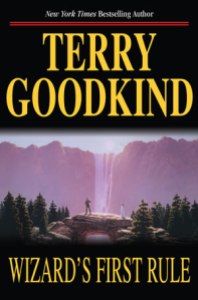When most people think of multi-volume fantasy epics, they invariably think of the Sword of Truth series by Terry Goodkind. Without a doubt, it’s one of the most popular and enduring series in the genre, spawning twelve novels and a short-lived live-action television series. Wizard’s First Rule is the original entry in the series, so I thought I’d give it a shot to see what all the fuss is about.
After four months of tedious on-and-off reading, I stillI don’t understand the fascination with this series. The writing isn’t particularly impressive, and neither is the world or the characters or the themes or really anything else in it. I felt like I was reading a patchwork of fantasy. Richard is a stereotypical male hero; Kahlan is halfway decent compared to others, but ultimately uninteresting; Zed is exactly what you think of when you think of a wizard. There’s nothing very original about this book, nothing to differentiate it from everything that’s come before.
Let’s start with the rules of the world––there are way, way, way too many. Everyone is bound by magical law to do one thing or another, and it seems like more and more rules are added to the list with each passing chapter. To illustrate my point, there are probably around five to ten campfire conversations where everyone sits around and chats. But instead of telling scary stories boy-scout style, they all try to explain to the reader how things work in the Midlands. They usually go something like this:
…
ZEDD: So Richard, you’re the Seeker, which essentially means that you walk around with a big sword looking for truth.
RICHARD: Looking for truth? What does that mean?
ZEDD: I don’t know. And no one’s going to explain it. There are like twenty more books left for readers to figure out what the hell’s going on.
RICHARD: But––
ZEDD: Moving on. There are these boxes, right? And this dude named Darken Rahl wants them because if you open all three before winter, you get, like, limitless power and you can open up the underworld and stuff.
RICHARD: Who made the boxes? And why does this guy want to open the underworld?
ZEDD: Don’t worry about it. Point is, you need to kill this guy because he killed your father…well, the guy you think is your father. Spoiler: it turns out Darken’s your daddy.
RICHARD: Hey, wasn’t that already the major plot twist in Star Wars?
ZEDD: Uhh…
…
Okay, I admit it, this isn’t really what their campfire chats are like. They’re a lot longer, and there are far fewer logical questions being asked. The world is based on rules that seem to change depending on the situation the writer finds his characters in.
For example, at the end of the novel, when everything seems lost, Kahlan goes into this sacred rage called the Con-Dar, setting up Rahl’s downfall. It isn’t explained or even alluded to until the very end of the book, and as a result it comes out of nowhere and seems incredibly convenient. Talk about deus ex machina.
As I said earlier, for a series that’s supposedly character driven, the characters of Wizard’s First Rule are anything but compelling. They feel mechanical rather than organic, acting because they’re told to and not because they choose to. They don’t have very much agency, and as a result become monotonous, if not downright boring. And to make matters worse, many of them are noticeably derivative.
The best example of this problem is Samuel. Let me describe him to you, and you tell me who he sounds like. Samuel is a wretched, tortured little man who runs around on his arms and legs like a dog. He used to be a normal being, but he was twisted by the magic of an ancient artifact and is now hopelessly bound to it. His purpose in the story is to illustrate what will happen to the protagonist if he should fail in his quest.
Sound familiar? That’s right folks. Samuel is Gollum.
The only halfway unique or interesting character in the whole book is Denna, a torturer hired by Darken Rahl to break Richard. Though at first she appears to be merciless and cruel, she and Richard develop an unlikely bond of love. Just when she begins to get really interesting, guess what happens? Richard has to kill her.
The best thing I can say for Wizard’s First Rule is that I could finish it. It’s just interesting enough that you want to know what happens, but the payoff is just like the first 600 pages: completely derivative. I was really hoping that Darken Rahl wouldn’t turn out to be Richard’s father. I really was. Having the antagonist be the protagonist’s father became instant cliche when they did it in Star Wars…so why do it again?
…
Wizard’s First Rule might be somewhat engaging to someone who’s never read a fantasy novel before. But if you’re at all familiar with the genre, you’ll recognize every character, every theme, and every plot twist.
Rating: 3/10

